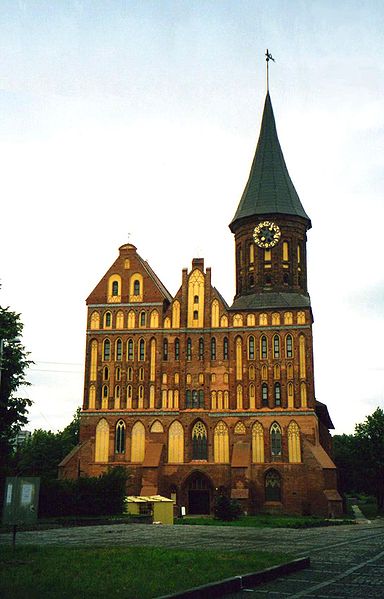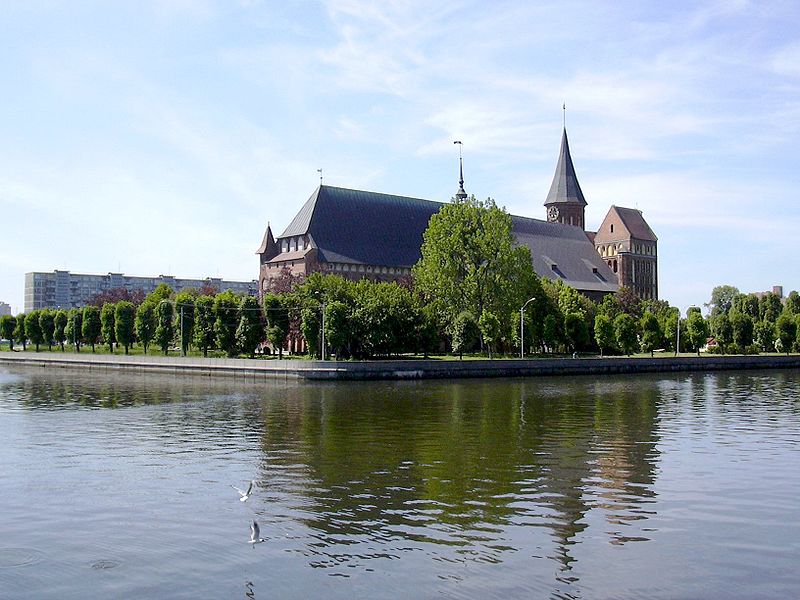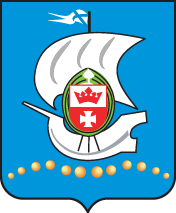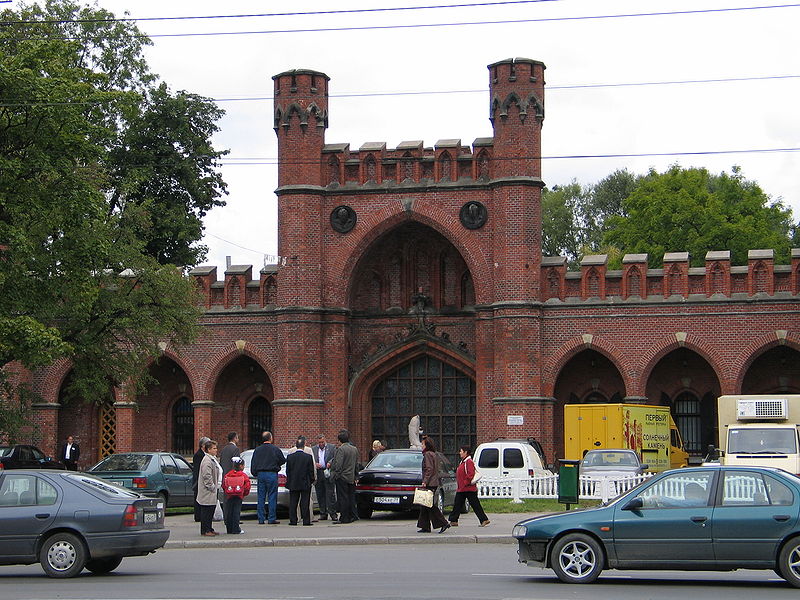<Back to Index>
- East Prussia, German Empire Königsberg (Kaliningrad), 287K
PAGE SPONSOR
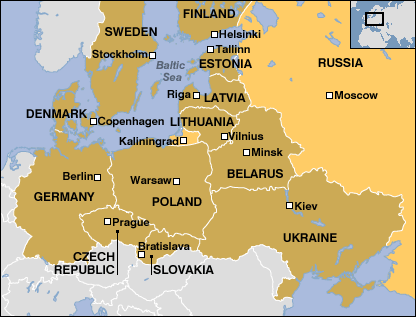
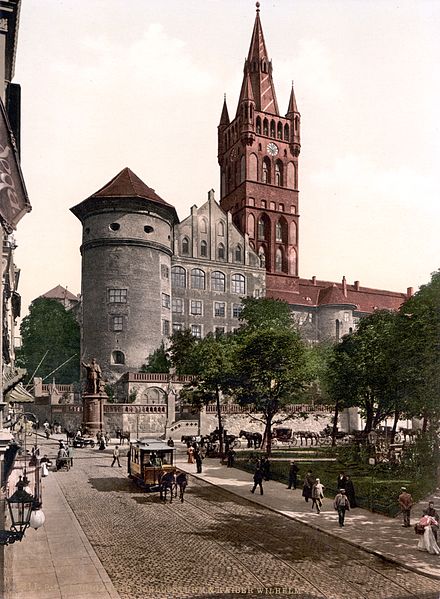
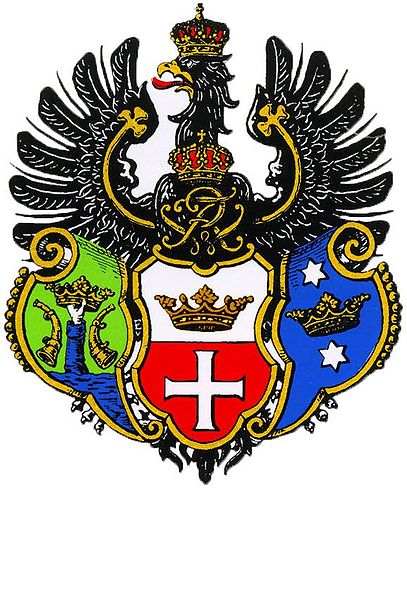
Königsberg was the capital of East Prussia from the Late Middle Ages until 1945 as well as the northernmost (following the loss of Memel in 1923) and easternmost German city with 286,666 inhabitants (Großstadt, 'great city'). Due to the multicultural society in and around the city, there are several local names for it. The official name was Königsberg in Preußen (abbreviated Königsberg i. Pr. (until 1936) and later Königsberg (Pr) (1936 – 1946)), Königsberg in Prussia). Königsberg's literal meaning is 'King's Mountain'. Its Latinized form was Regimontium Prussorum. In Modern Saxon or "Low German", a Germanic language spoken by many of its German inhabitants, the name was Königsbarg, mixing German König (nds. köning) with Low German barg (hill, mountain). Further names include Lithuanian: Karaliaučius; Polish:Królewiec and the modern Russian and current official name Калинингра́д, Kaliningrad), amongst others.
It was founded by the Teutonic Knights just south of the Sambian peninsula in 1255 during the Northern Crusades and named in honor of King Ottokar II of Bohemia (the German language name Königsberg literally means "King's mountain"). The city successively became the capital of their monastic state, the Duchy of Prussia, and East Prussia. The Baltic port developed into a German cultural center, being the residence of, among others, Richard Wagner, Immanuel Kant, E.T.A. Hoffmann, and David Hilbert.
Königsberg was heavily damaged by Allied bombing in 1944 during World War II and was subsequently conquered by the Red Army after the Battle of Königsberg in 1945. The city was annexed by the Soviet Union, its German population expelled and repopulated with Russians. Briefly Russified as Кёнигсберг (Kyonigsberg), it was renamed Kaliningrad in 1946 after Soviet leader Mikhail Kalinin. The city is now the capital of Russia's Kaliningrad Oblast.
The later location of Königsberg was preceded by an Old Prussian fort known as Twangste (Tuwangste, Tvankste) as well as several Prussian settlements. During the conquest of the Prussian Sambians by the Teutonic Knights in 1255, Twangste was destroyed and replaced with a new fortress known as Conigsberg. This name meant "King's Mountain" (Latin: castrum Koningsberg, Mons Regius, Regiomonti), honoring King Ottokar II of Bohemia, who paid for the erection of the first fortress there during the Prussian Crusade. Near this new Königsberg Castle arose the towns of Altstadt (Old Town), Kneiphof, and Löbenicht along the Pregel River, roughly 4.5 miles from the Vistula Lagoon. Altstadt was founded in 1256 on the Steindamm (now Leninprospekt), while Kneiphof developed on an island of the same name (now Kant Island) in the Pregel. To the east of the other two towns was Löbenicht, lying between the Schlossteich and the new Pregel.
The Teutonic Order used Königsberg to fortify their conquests in Samland and as a base for campaigns against pagan Lithuania. Under siege during the Prussian uprisings in 1262 – 63, Königsberg was relieved by the Master of the Livonian Order. Altstadt was destroyed by the Prussians during the rebellion and rebuilt in the valley below the castle hill. Altstadt received Culm rights in 1286, while Kneiphof received its charter in 1327.
Within the monastic state of the Teutonic Knights, Königsberg was the residence of the marshal, one of the chief administrators of the military order. The city was also the seat of the Bishopric of Samland, one of the four dioceses into which Prussia had been divided in 1243 by the papal legate, William of Modena. Adalbert of Prague became the main patron saint of Königsberg Cathedral, a landmark of the city located in Kneiphof.
Königsberg joined the Hanseatic League in 1340 and developed into an important port for the southeastern Baltic region, trading goods throughout Prussia, the Kingdom of Poland, and the Grand Duchy of Lithuania. The chronicler Peter of Dusburg probably wrote his Chronicon terrae Prussiae in Königsberg from 1324 – 1330. After the Teutonic Order's victory over pagan Lithuanians in the 1348 Battle of Strawen, Grand Master Winrich von Kniprode established a Cistercian nunnery in the city. Aspiring students were educated in Königsberg before continuing on to higher education elsewhere, such as Prague or Leipzig.
Although the knights suffered a crippling defeat in the Battle of Grunwald (Tannenberg), Königsberg remained under the control of the Teutonic Knights throughout the Polish - Lithuanian - Teutonic War. Livonian knights replaced the Prussian branch's garrison at Königsberg, allowing them to participate in the recovery of towns occupied by Jogaila's troops.
The Prussian Confederation rebelled
against the Teutonic Knights in 1454 and sought the assistance of
Poland. Kneiphof supported the rebellion, although the rest of
Königsberg reaffirmed its loyalty to the order. Grand Master Ludwig von Erlichshausen fled from the crusaders' capital at Castle Marienburg to Königsberg in 1457; the city's magistrate presented Erlichshausen with a barrel of beer out of compassion. When western Prussia was transferred to victorious Poland in the Second Peace of Thorn (1466), which ended the Thirteen Years' War, Königsberg became the new capital of the reduced monastic state, which became a fief of the Crown of the Polish Kingdom. The grand masters took over the quarters of the marshal. During the Polish - Teutonic War (1519 – 1521), Königsberg was unsuccessfully besieged by Polish forces led by Grand Crown Hetman Mikołaj Firlej.
Through the preachings of the Bishop of Samland, Georg von Polenz, Königsberg became predominantly Lutheran during the Protestant Reformation. After summoning a quorum of knights to Königsberg, Grand Master Albert of Brandenburg from the Hohenzollern dynasty secularized the Teutonic Knights' remaining territories in Prussia in 1525 and converted to Lutheranism. By paying feudal homage to his uncle, King Sigismund I of Poland, Albert became the first duke of the new Duchy of Prussia, a fief of Poland. While the Prussian estates quickly allied with the duke, the Prussian peasantry would only swear allegiance to Albert in person at Königsberg, seeking the duke's support against oppressive nobility. After convincing the rebels to lay down their arms, Albert had several of their leaders executed.
Königsberg, the capital of the duchy, became one of the biggest cities and ports of Prussia, having considerable autonomy, a separate parliament and currency, and with German as its dominant language. The city flourished through the export of wheat, timber, hemp, and furs, as well as pitch, tar, and ash. Königsberg was one of the few Baltic ports regularly visited by more than one hundred ships annually in the latter 16th century, the others being Danzig and Riga. The University of Königsberg, founded by Albert in 1544, became a center of Protestant teachings.
The capable Duke Albert was succeeded by his feeble minded son, Albert Frederick. Anna, daughter of Albert Frederick, married Elector John Sigismund of Brandenburg, who was granted the right of succession to Prussia on Albert Frederick's death in 1618. From this time the Duchy of Prussia and Königsberg were ruled by the Electors of Brandenburg, the rulers of Brandenburg - Prussia.
Because Brandenburg was overrun by Sweden during the Thirty Years' War, the Hohenzollern court fled to Königsberg. On 1 November 1641, Elector Frederick William persuaded the Prussian diet to accept an excise tax. In the Treaty of Königsberg of January 1656, the elector recognized his Duchy of Prussia as a fief of Sweden. In the Treaty of Wehlau in 1657, however, he negotiated the release of Prussia from Polish sovereignty in return for an alliance with Poland. The 1660 Treaty of Oliva confirmed Prussian independence from both Poland and Sweden.
In 1661 Frederick William informed the Prussian diet he possessed jus supremi et absoluti domini, and that the Prussian Landtag could only be convened with his permission. The Königsberg burghers, led by Hieronymus Roth of Kneiphof, opposed "the Great Elector's" absolutist claims, but Frederick William succeeded in imposing his authority after arriving with 2,000 troops in October 1661. Refusing to request mercy, Roth was imprisoned in Peitz until his death in 1678.
The Prussian estates, which swore fealty to Frederick William in Königsberg on October 18, 1663, refused the elector's requests for military funding, and Colonel Christian Ludwig von Kalckstein sought assistance from neighboring Poland. After Kalckstein was abducted by the elector's agents, he was executed in 1672. The Prussian estates' submission to Frederick William followed; in 1673 and 1674 the elector received taxes not granted by the estates and Königsberg received a garrison without the estates' consent. The economic and political weakening of Königsberg strengthened the power of the Junker nobility within Prussia.
Königsberg was long a center of Lutheran resistance to Calvinism within Brandenburg - Prussia; Frederick William forced the city to accept Calvinist citizens and property holders in 1668.
By the act of coronation in Königsberg Castle on January 18, 1701, Frederick William's son, Elector Frederick III, became Frederick I, King in Prussia. The elevation of the Duchy of Prussia to the Kingdom of Prussia was possible because the Hohenzollerns' authority in Prussia was independent of Poland and the Holy Roman Empire. Since "Kingdom of Prussia" was increasingly used to designate all of the Hohenzollern lands, former ducal Prussia became known as the Province of Prussia (1701 – 1773), with Königsberg as its capital. However, Berlin and Potsdam in Brandenburg were the main residences of the Prussian kings.
The city was wracked by plague and other illnesses from September 1709 to April 1710, losing 9,368 people, or roughly a quarter of its populace. On June 13, 1724, Altstadt, Kneiphof, and Löbenicht amalgamated to formally create the larger city Königsberg. Suburbs that subsequently were annexed to Königsberg include Sackheim, Rossgarten, and Tragheim.
Imperial Russian troops occupied eastern Prussia at the beginning of 1758 during the Seven Years' War. On December 31, 1757, Empress Elizabeth I of Russia issued a ukase about the incorporation of Königsberg into Russia. On January 24, 1758, the leading burghers of Königsberg submitted to Elizabeth. Five Imperial Russian general - governors administered the city during the war from 1758 – 62; the Russian army did not abandon the town until 1763.
After the First Partition of Poland in 1772, Königsberg became the capital of the province of East Prussia in 1773, which replaced the Province of Prussia in 1773. By 1800 the city was approximately five miles in circumference and had 60,000 inhabitants, including a military garrison of 7,000, making it one of the most populous German cities of the time.
After Prussia's defeat at the hands of Napoleon Bonaparte in 1806 during the War of the Fourth Coalition, King Frederick William III of Prussia fled with his court from Berlin to Königsberg. The city was a center for political resistance to Napoleon. In order to foster liberalism and nationalism among the Prussian middle class, the "League of Virtue" was founded in Königsberg in April 1808. The French forced its dissolution in December 1809, but its ideals were continued by the Turnbewegung of Friedrich Ludwig Jahn in Berlin. Königsberg officials, such as Johann Gottfried Frey, formulated much of Stein's 1808 Städteordnung, or new order for urban communities, which emphasized self - administration for Prussian towns. The East Prussian Landwehr was organized from the city after the Convention of Tauroggen.
In 1819 Königsberg had a population of 63,800. It served as the capital of the united Province of Prussia from 1824 – 1878, when East Prussia was merged with West Prussia. It was also the seat of the Regierungsbezirk Königsberg, an administrative subdivision.
Led by the provincial president Theodor von Schön and the Königsberger Volkszeitung newspaper, Königsberg was a stronghold of liberalism against the conservative government of King Frederick William IV. During the revolution of 1848, there were 21 episodes of public unrest in the city; major demonstrations were suppressed. Königsberg became part of the German Empire in 1871 during the Prussian led unification of Germany. A sophisticated for its time series of fortifications around the city that included fifteen forts was completed in 1888.
The extensive Prussian Eastern Railway linked the city to Breslau, Thorn, Insterburg, Eydtkuhnen, Tilsit, and Pillau. In 1860 the railroad connecting Berlin with St. Petersburg was completed and increased Königsberg's commerce. Extensive electric tramways were in operation by 1900; and regular steamers plied to Memel, Tapiau and Labiau, Cranz, Tilsit, and Danzig. The completion of a canal to Pillau in 1901 increased the trade of Russian grain in Königsberg, but, like much of eastern Germany, the city's economy was generally in decline. By 1900 the city's population had grown to 188,000, with a 9,000 strong military garrison. By 1914 Königsberg had a population of 246,000; Jews flourished in the culturally pluralistic city.
Following the defeat of the Central Powers in World War I, Imperial Germany was replaced by the democratic Weimar Republic. The Kingdom of Prussia ended with the abdication of the Hohenzollern monarch, William, and the kingdom was succeeded by the Free State of Prussia. Königsberg and East Prussia, however, were separated from the rest of Weimar Germany by the creation of the Polish Corridor.
The Ostmesse (Eastern Trade Fair) at the Königsberg Tiergarten was
held annually starting in 1920; it was intended to compensate for the
geographical distance that handicapped the economic development of East
Prussia and Königsberg. In 1922 the first permanent airport and commercial terminal solely for commercial aviation was built at Königsberg - Devau. In 1929, Königsberg amalgamated with some surrounding suburbs.
Shortly after the July 1932 federal election, the Free State of Prussia's long serving Social Democratic government under Otto Braun was deposed in the Preußenschlag, when Germany's chancellor Franz von Papen assumed direct federal control of Prussia's administration. During Nazi rule from 1933 to 1945, Gauleiter Erich Koch replaced the elected government of Prussia, which together with much of the old eastern Germany was one of the most Pro - Nazi provinces in the Reich, with over 55% of votes cast in favor of the Nazi Party in the March 1933 election.
In 1935, the Wehrmacht designated Königsberg as the Headquarters for Wehrkreis I, (under the command of General der Artillerie Albert Wodrig) which originally took in all of East Prussia. Wehrkreis I was extended in March 1939 to include the Memel area. In October 1939, it was extended again to include the Ciechanów and Suwałki areas. In 1942, the Wehrkreis was again expanded to include the Białystok district. Army units that called Königsberg home included the I Infantry Corps, which was part of the pre - Nazi era Standing Army, and the 61st Infanterie Division, which was formed upon mobilization from reservists from East Prussia. It took part in the invasion of Belgium, which was part of Case Yellow, and Operation Barbarossa, the invasion of the Soviet Union. In Book XII of his World War II, Winston Churchill referred to Königsberg as "a modernised heavily defended fortress".
According to the census of May 17, 1939, Königsberg had a population of 372,164. After Breslau, it was the second largest city in Germany east of the present day Oder - Neisse line.
Following
World War I Königsberg was home to one third of East Prussia's
13,000 Jews. The city's Jewish population shrank from 3,200 in 1933 to
2,100 in October 1938. The New Synagogue of Königsberg, constructed in 1896, was destroyed during Kristallnacht (November 9, 1938); 500 Jews soon fled the city. After the Wannsee Conference of January 20, 1942, Königsberg's Jews began to be deported to camps such as Maly Trostenets, Theresienstadt, and Auschwitz.
The city hosted Radio Königsberg, a propaganda station, during World War II.
In 1944 Königsberg suffered heavy damage from British bombing attacks and burned for several days. The historic city center, especially the original quarters Altstadt, Löbenicht, and Kneiphof, was completely destroyed, including the cathedral, the castle, all churches of the old city, the old and the new universities, and the old shipping quarters.
Many people fled Königsberg ahead of the Red Army's advance after October 1944, particularly after word spread of the Soviet atrocities at Nemmersdorf. In early 1945 Soviet forces under the overall command of Vasilievsky, besieged the city. In Operation Samland,General Baghramyan's 1st Baltic Front, now known as the Samland Group, captured Königsberg in April. A temporary German breakout had allowed many of the remaining civilians to escape via train and naval evacuation from the nearby port of Pillau. Königsberg, which had been declared a "fortress" (Festung) by the Germans, was fanatically defended.
On 21 January during the Red Army's East Prussian Offensive, mostly Polish and Hungarian Jews from Seerappen, Jesau, Heiligenbeil, Schippenbeil, and Gerdauen (subcamps of Stutthof concentration camp) were gathered in Königsberg. Up to 7,000 of them were forced on a death march to Sambia; those that survived were subsequently executed at Palmnicken.
On April 9 — one month before the end of the war in Europe — the German military commander of Königsberg, General Otto Lasch, surrendered the remnants of his forces following a Red Army assault. At the time of the surrender, military and civilian dead in the city were estimated at 42,000, with the Red Army claiming over 90,000 prisoners. Lasch's subterranean command bunker has been preserved as a museum, with the rest of the 19th century fortification complex being abandoned after use by the Soviet Army until the 1980s as a storage facility.
About
120,000 survivors remained in the ruins of the devastated city. These
survivors, mainly women, children and the elderly and a few others who
returned immediately after the fighting ended, were held as virtual
prisoners until 1949. The large majority of German citizens remaining in
Königsberg after 1945 died of either disease, starvation or
revenge driven ethnic cleansing. The remaining 20,000 German residents were expelled in 1949 – 50.
At the end of World War II in 1945, the city was annexed by the Soviet Union pending the final determination of territorial questions at the peace settlement (as part of the Russian SFSR) as agreed upon by the Allies at the Potsdam Conference:
VI. CITY OF KOENIGSBERG AND THE ADJACENT AREA
The Conference examined a proposal by the Soviet Government that pending the final determination of territorial questions at the peace settlement, the section of the western frontier of the Union of Soviet Socialist Republics which is adjacent to the Baltic Sea should pass from a point on the eastern shore of the Bay of Danzig to the east, north of Braunsberg and Goldap, to the meeting point of the frontiers of Lithuania, the Polish Republic and East Prussia. The Conference has agreed in principle to the proposal of the Soviet Government concerning the ultimate transfer to the Soviet Union of the city of Koenigsberg and the area adjacent to it as described above, subject to expert examination of the actual frontier. The President of the United States and the British Prime Minister have declared that they will support the proposal of the Conference at the forthcoming peace settlement.
After Königsberg's conquest by the Red Army, the name of the city briefly changed to a Russifiedform: Kyonigsberg (Кёнигсберг). While it was initially planned to rename the city "Baltijsk", it was renamed Kaliningrad on July 4, 1946, after the death of the Chairman of the Presidium of the Supreme Soviet of the USSR, Mikhail Kalinin, one of the original Bolsheviks. The Soviet Union applied the name "Baltiysk" to the nearby port of Pillau instead. The German population was either deported to the Western Zones of occupied Germany or into Siberian labor camps, where about half of them perished of hunger or diseases.
After the deportation, the city's former population was entirely replaced with Soviet citizens. Life changed dramatically: the city had a new name (Kaliningrad), and German was replaced by Russian as the language of everyday life. Parts of the city were rebuilt, although the former Altstadt remained an urban fallow with few buildings that survived the destruction. The city went through industrialization and modernization. As one of the westernmost territories of the Soviet Union, the Kaliningrad Oblast became a strategically important area during the Cold War. The Soviet Baltic Fleet was headquartered in the city in the 1950s. Because of its strategic importance, Kaliningrad was closed to foreign visitors.
The vast majority of the population belonged to the Lutheran Church and other Protestant denominations.
Königsberg was the birthplace of the mathematician Christian Goldbach and the writer E.T.A. Hoffmann, as well as the home of the philosopher Immanuel Kant, who lived there all his life and never traveled more than a hundred miles away from the city. Kant entered the university of Königsberg at age 16 and was appointed to a chair in metaphysics there in 1770 at the age of 46. While working there he published his Critique of Pure Reason (arguing that knowledge arises from the application of innate concepts to sensory experience) and his Metaphysics of Morals which argues that virtue is acquired by the performance of duty for its own sake. In 1736, the mathematician Leonhard Euler used the arrangement of the city's bridges and islands as the basis for the Seven Bridges of Königsberg Problem, which led to the mathematical branches of topology and graph theory. In the 19th century Königsberg was the birthplace of the influential mathematician David Hilbert.
The dialect spoken by most citizens was Low Prussian, now a moribund language as its speakers are elderly and dying out. A popular dish from the city was Königsberger Klopse, which is still made today in some specialty restaurants in Kaliningrad and present day Germany; some recipes are available on the web.
In
the Königsstraße (King Street) stood the Academy of Art with
a collection of over 400 pictures. About 50 works were by Italian masters; and some early Dutch paintings were also to be found there. At the Königstor (King's Gate) stood statues of King Ottakar I of Bohemia, Albert of Prussia, and Frederick I of Prussia.
Königsberg had a magnificent Exchange (completed in 1875) with
fine views of the harbor from the staircase. Along Bahnhofsstraße
("Railway Street") were the offices of the famous Royal Amber Works —
Samland was celebrated as the "Amber Coast". There was also an observatory fitted up by the astronomer Friedrich Bessel,
a botanical garden, and a zoological museum. The "Physikalisch", near
the Heumarkt, contained botanical and anthropological collections and
prehistoric antiquities. Two large theaters built during the Wilhelmine era were the Stadt (city) Theatre and the Appollo.
Königsberg Castle was one of the city's most notable structures. The former seat of the Grand Masters of the Teutonic Knights and the Dukes of Prussia, it contained the Schloßkirche, or palace church, where Frederick I was crowned in 1701 and William I in 1861. It also contained the spacious Moscowiter - Saal, one of the largest halls in the German Reich, and a museum of Prussian history.
Königsberg became a center of education when the Albertina University was founded by Duke Albert of Prussia in 1544. The university was situated opposite the north and east side of the Königsberg Cathedral. Lithuanian scholar Stanislovas Rapalionis, one of founding fathers of the university, was the first professor of theology.
Numerous German and Polish publications were printed in Königsberg espousing the Protestant Reformation. The city became a center for the publication of books in the Lithuanian language, especially by educated Prussian Lithuanians from Lithuania Minor. After the territory became Lutheran, prayer books were printed in the Lithuanian vernacular. The first non - religious Lithuanian books were published later as well. With the support of the government, Ruhig (Pilypas Ruigys) and Mielcke (Kristijonas Gotlybas Milkus) published Lithuanian dictionaries in 1747 and 1800, respectively.
Sports clubs which played in Königsberg included VfB Königsberg and SV Prussia - Samland Königsberg. Lilli Henoch, the world record holder in the discus, shot put, and 4 × 100 meters relay events who was killed by the Nazis, was born in Königsberg.
